
Gongora, abbreviated Gga in horticultural trade, is a member of the orchid family (Orchidaceae). It consists of 65 species known from Central America, Trinidad, and tropical South America, with most species found in Colombia. They grow across a wide geographical range, from wet forests at sea level, to mountainous regions in the Andes, as high as 1,800 m.

Chusquea is a genus of evergreen bamboos in the grass family. Most of them are native to mountain habitats in Latin America, from Mexico to southern Chile and Argentina.

Oncidium, abbreviated as Onc. in the horticultural trade, is a genus that contains about 330 species of orchids from the subtribe Oncidiinae of the orchid family (Orchidaceae). As presently conceived, it is distributed across much of South America, Central America, Mexico and the West Indies, with one species (O. ensatum) extending into Florida. Common names for plants in this genus include dancing-lady orchid and golden shower orchid.
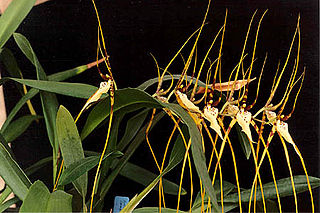
Brassia is a genus of orchids classified in the subtribe Oncidiinae. It is native to Mexico, Central America, the West Indies, and northern South America, with one species extending into Florida.

The Guajira Peninsula is a peninsula in northern Colombia and northwestern Venezuela in the Caribbean. It is the northernmost peninsula in South America and has an area of 25,000 km2 (9,700 sq mi) extending from the Manaure Bay (Colombia) to the Calabozo Ensenada in the Gulf of Venezuela (Venezuela), and from the Caribbean to the Serranía del Perijá mountains range.

Ponthieva is a genus in the orchid family (Orchidaceae), commonly known as the shadow witch. They are named after Henry de Ponthieu, an English merchant of Huguenot ancestry who sent West Indian plant collections to Sir Joseph Banks in 1778.
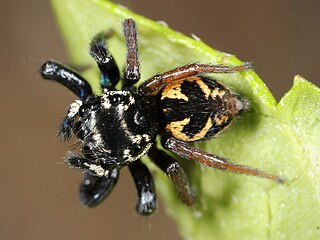
Corythalia is a genus of jumping spiders that was first described by Carl Ludwig Koch in 1850. The genus is distributed throughout most of the Western Hemisphere. Species of this genus are found in The Americas.
Scopocira is a genus of jumping spiders that was first described by Eugène Louis Simon in 1900.

Oenocarpus is a genus of pinnate-leaved palms (Arecaceae) native to Trinidad, southern Central and tropical South America. With nine species and one natural hybrid, the genus is distributed from Costa Rica and Trinidad in the north to Brazil and Bolivia in the south.
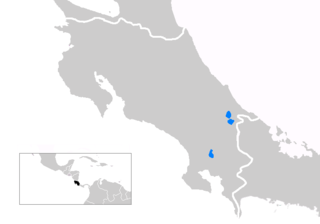
Bribri, also known as Bri-bri, Bribriwak, and Bribri-wak, is a Chibchan language, from a language family indigenous to the Isthmo-Colombian Area, which extends from eastern Honduras to northern Colombia and includes populations of those countries as well as Nicaragua, Costa Rica, and Panama. As of 2002, there were about 11,000 speakers left. An estimate by the National Census of Costa Rica in 2011 found that Bribri is currently spoken by 54.7% of the 12,785 Bribri people, about 7,000 individuals. It is a tonal language whose word order is subject–object–verb.

Brunellia is a genus of trees. They are distributed in the mountainous regions of southern Mexico, Central America, West Indies, and South America. Brunellia is the only genus in the family Brunelliaceae. As of 2001 there were about 54 species.

Renealmia is a plant genus in the family Zingiberaceae. Its members are native to tropical Africa and tropical America. In Peru, fruits and tubers are sources of indigenous dyes. and indigenous medical treatments for leishmania and malaria In Colombia, it is used to treat snakebite. Bracts and leaves can serve as phytotelmata, retaining small quantities of water that offer habitat for other organisms.
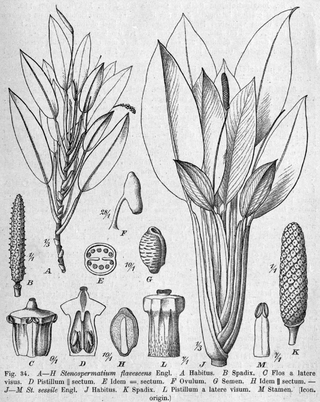
Stenospermation is a genus of plant in family Araceae native to South America and Central America.

Mixotoxodon is an extinct genus of notoungulate of the family Toxodontidae inhabiting South America, Central America and parts of southern North America during the Pleistocene epoch, from 1,800,000—12,000 years ago.
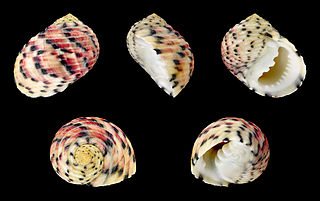
Nerita versicolor is a species of sea snail, a marine gastropod mollusk in the family Neritidae.

Cupiennius, known by the common name bromeliad spiders or as the often confused name banana spiders, is a genus of araneomorph spiders in the family Trechaleidae, named by Eugène Simon in 1891. They are found from Mexico to northwestern South America, and on some Caribbean islands. Unlike the dangerously venomous Phoneutria, bites from these spiders typically have only minor effects on humans, and have been compared to a bee sting.

Macroscepis is a genus of plants in the family Apocynaceae, first described as a genus in 1819. It is native to Latin America and the West Indies.

Mangora is a genus of orb-weaver spiders first described by O. Pickard-Cambridge in 1889.
Chrysometa is a genus of long-jawed orb-weavers that was first described by Eugène Louis Simon in 1894. It is a senior synonym of Capichameta.

















